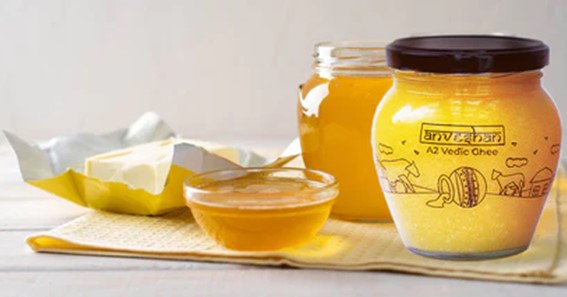Are you curious to know what is vanaspati? You have come to the right place as I am going to tell you everything about vanaspati in a very simple explanation. Without further discussion let’s begin to know what is vanaspati?
In the culinary world, cooking oils play a significant role in enhancing flavors, textures, and nutritional values of dishes. Among the diverse range of cooking oils, “Vanaspati” stands as a unique and intriguing contender. Vanaspati is a hydrogenated vegetable oil that has found its place in various culinary traditions and food industries. In this blog, we’ll dive into the world of Vanaspati, its production, uses, controversies, and the considerations surrounding its consumption.
What Is Vanaspati?
Vanaspati is a hydrogenated or partially hydrogenated vegetable oil derived from plant sources such as soybean, palm, cottonseed, and groundnut. The process of hydrogenation involves adding hydrogen to liquid vegetable oils to solidify them and increase their shelf life. This process also transforms the oils into a semi-solid or solid state, resembling the texture of ghee (clarified butter) while being more economical to produce.
Production Of Vanaspati
The production of Vanaspati involves several steps:
- Oil Extraction: Vegetable oils are extracted from various plant sources through mechanical or chemical processes.
- Hydrogenation: The extracted oils are then subjected to hydrogenation, where hydrogen gas is passed through the oil in the presence of a catalyst. This process saturates the oil’s unsaturated fatty acids, making it more solid and stable at room temperature.
- Cooling and Solidification: After hydrogenation, the oil is cooled and solidified to achieve the desired texture of Vanaspati.
- Blending and Packaging: The solidified Vanaspati may be blended with other ingredients for flavor, color, and stability. It is then packaged and made available for consumers.
Uses Of Vanaspati
Vanaspati is used in a variety of culinary applications, both in households and food industries:
- Cooking: Vanaspati is used as a cooking medium for frying, sautéing, and baking. It offers a high smoke point, making it suitable for deep frying.
- Confectionery: It is used in the production of bakery products, pastries, and snacks, contributing to texture and shelf life.
- Street Food: In some regions, Vanaspati is commonly used for preparing street food items due to its affordability and stability at high temperatures.
Controversies And Considerations
While Vanaspati has its uses, there are concerns and controversies associated with its consumption:
- Trans Fats: The hydrogenation process used to produce Vanaspati results in the formation of trans fats, which have been linked to adverse health effects, including increased risk of heart diseases.
- Health Impact: Due to its trans fat content, Vanaspati is considered less healthy compared to other cooking oils like vegetable oils or ghee.
- Regulations: Many countries have implemented regulations to limit or ban trans fats in food products, which has led to reduced consumption of Vanaspati in those regions.
Conclusion
Vanaspati has left its mark in the culinary landscape, offering an affordable cooking medium with specific textural qualities. However, the concerns related to trans fats and their impact on health have prompted both consumers and the food industry to reevaluate its use. As awareness about the health implications of trans fats grows, many individuals are opting for healthier cooking oils and alternatives. In the ever-evolving realm of nutrition and dietary choices, the role of Vanaspati continues to be debated, highlighting the delicate balance between taste, tradition, and well-being.
FAQ
What Is Vanaspati Made Of?
Vanaspati means any refined edible vegetable oil or oils subjected to a process of hydrogenation in any form. consumer VOice tested 12 brands of hydrogenated vegetable oil or vanaspati, and found that all brands were made from palm/palmolein oil.
What Is Called Vanaspati?
Hydrogenated vegetable oil
Vanaspati or Banaspati is also a South Asian slang for Vanaspati/Banaspati ghee of which “Dalda” is the leading brand in Indian markets. Vanaspati is a fully or partially hydrogenated vegetable cooking oil, often used as a cheaper substitute for ghee and butter.
What Is Vanaspati And Dalda?
Dalda was actually the name of the Dutch company that imported vanaspati ghee into India in the 1930s as a cheap substitute for desi ghee or clarified butter, prepared from cow’s milk. In British India of those colonial days, desi ghee was considered an expensive product and not easily affordable for the common public.
Is Vanaspati And Dalda Same?
Dalda is a brand that makes vanaspati, it’s hydrogenated vegetable oil usually palm oil (as you see a palm tree in the company logo). It’s very high in trans fat and it’s suggested that you totally avoid it. Vanaspati and Margarine, totally avoid.
I Have Covered All The Following Queries And Topics In The Above Article
What Is Vanaspati
What Is Vanaspati Ghee
What Is Vanaspati Ghee Made Of
What Is Vanaspati Oil
What Is Vanaspati Made Of
What Is Dalda Vanaspati
What Is Vanaspati Dalda
What Is The Difference Between Vanaspati And Ghee
What Is Vanaspati Called In English
What Is The Meaning Of Vanaspati
What Is Meant By Vanaspati
What Is Vanaspati Print
What Is Mean By Vanaspati
What Is Vanaspati In Hindi
What Is Vanaspati
What does Vanaspati mean?
